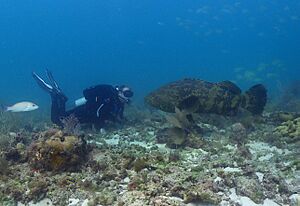Atlantic goliath grouper facts for kids
Quick facts for kids Atlantic goliath grouper |
|
|---|---|
 |
|
| Conservation status | |
| Scientific classification | |
| Synonyms | |
|
The Atlantic goliath grouper is a giant saltwater fish. It is also known as the itajara. This amazing fish belongs to the grouper family. It is one of the largest types of bony fish in the world.
You can find the Atlantic goliath grouper in several places. They live in the western Atlantic Ocean. This includes areas from Florida down through the Gulf of Mexico and the Caribbean Sea. They also live along the coast of South America to Brazil. In the eastern Pacific, they are found from Mexico to Peru. In the eastern Atlantic, they live off the coast of West Africa. These fish can be seen at different depths, from about 3 feet (1 meter) to 330 feet (100 meters) deep.
Contents
What's in a Name?
The Atlantic goliath grouper was once called the "jewfish". The reason for this old name is not fully clear. In 2001, the American Fisheries Society decided to change the name. They changed it to "goliath grouper" because the old name was seen as culturally insensitive. This new name helps everyone feel respected.
Meet the Goliath Grouper
The Atlantic goliath grouper is truly huge! It can grow up to 8 feet (2.5 meters) long. It can also weigh as much as 800 pounds (363 kg). That's like a small car!
These fish can be brownish-yellow, gray, or greenish. They have small black dots on their head, body, and fins. Younger fish, less than 3 feet (1 meter) long, have faint vertical stripes on their sides.
The goliath grouper has a long body. Its head is wide and flat, with small eyes. It has several rows of teeth on its lower jaw. Its scales are rough, like sandpaper. The fins on its back are connected. Its side fins are large and rounded. The tail fin is also rounded. These big fish usually eat slow-moving fish and crustaceans like crabs.
Where They Live
Adult goliath groupers like to live in certain places. They are often found around rocky reefs and shipwrecks. They also like artificial reefs and oil platforms. You might see them in coral reefs too. However, they are much more common in rocky areas.
Young goliath groupers have a special home. They mostly live in mangrove forests. Mangroves are trees that grow in salty water along coastlines. They provide a safe place for young fish to grow. These young fish might stay in the mangroves for 5 to 6 years. Once they are about 3 feet (1 meter) long, they move to deeper ocean reefs.
How They Have Babies
Atlantic goliath groupers can live a long time, up to 37 years. They become old enough to have babies around 6 years old. Males are ready to reproduce when they are about 4-6 years old and 45 inches (115 cm) long. Females mature a bit later, at 6-8 years old and about 49 inches (125 cm) long.
These fish gather in groups to lay their eggs. These groups are usually smaller than 150 fish. They don't seem to have babies outside of these special gatherings.
Protecting the Goliath Grouper
Goliath groupers can easily become endangered. This is because of overfishing. People used to catch too many of them. Also, catching them when they gather to lay eggs hurts their numbers a lot.
Their babies also face challenges. They have a short time each year when they settle into new homes. Bad weather can really affect how many young fish survive. Also, pollution can harm older males. This can make them sick or even die.
The places where young goliath groupers grow, like mangrove forests, are also important. If these mangroves are damaged, fewer young fish will survive.
Because of these threats, the Atlantic goliath grouper was once listed as "critically endangered" in 2011. Now, in 2021, they are listed as "vulnerable." This means they are still at risk. From 1950 to 2014, their population dropped by about 33%.
To protect them, fishing for this species has been stopped. This ban started in U.S. waters in 1990. It began in U.S. Caribbean waters in 1993.
In October 2021, Florida decided to allow some fishing again. They proposed letting people catch 200 young goliath groupers each year. This includes up to 50 from Everglades National Park. This plan was approved in March 2022. Starting in spring 2023, Florida will give out 200 permits each year through a lottery.
Images for kids




